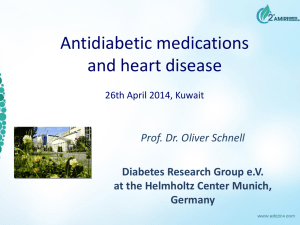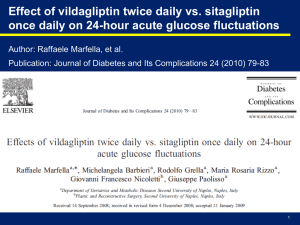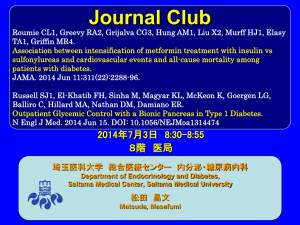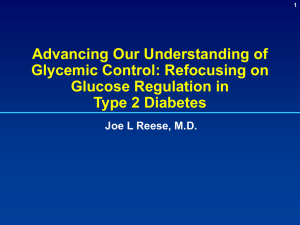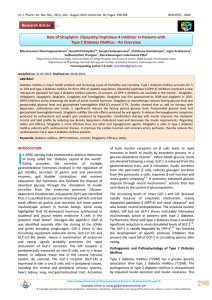File - Josephine Carlos
advertisement
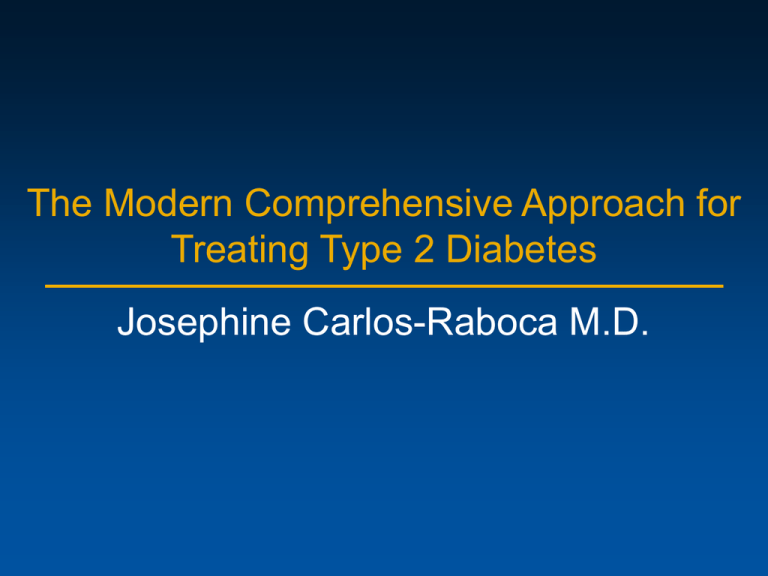
The Modern Comprehensive Approach for Treating Type 2 Diabetes Josephine Carlos-Raboca M.D. Table of Contents –Diabetes Pathophysiology –Comprehensive Approach is Pathophysiology Based –Therapy with DPP-4 Inhibitor 2 The Pathophysiology of Type 2 Diabetes Involves Multiple Organ Systems Peripheral Tissues Decreased Increased Glucose Uptake Lipolysis Liver Increased Glucose Production Pancreatic Beta Cells Decreased insulin secretion Pancreatic Alpha Cells Excessive glucagon secretion Insulin resistance Islet cell dysfunction Combined islet cell dysfunction and insulin resistance HYPERGLYCEMIA Adapted with permission from Inzucchi SE. JAMA 2002;287:360–372; Porte D Jr, Kahn SE. Clin Invest Med 1995;18:247–254. 3 Incretins Modulate Insulin and Glucagon to Decrease Blood Glucose During Hyperglycemia Meal Increased insulin (beta cells) GIP Muscle Adipose tissue Glucose Dependent Peripheral glucose uptake Gut GLP-1 Physiologic Glucose Control Pancreas Glucose Dependent Decreased glucagon (alpha cells) Liver Glucose production GLP-1=glucagon-like peptide-1; GIP=glucose-dependent insulinotropic polypeptide. Brubaker PL et al. Endocrinology 2004;145:2653–2659; Zander M et al. Lancet 2002;359:824–930; Ahren B. Curr Diab Rep 2003;3:365–372; Buse JB et al. In Williams Textbook of Endocrinology. 10th ed. Philadelphia, Saunders, 2003:1427–1483; Drucker DJ. Diabetes Care 2003;26:2929–2940. 4 Summary of Diabetic Pathophysiologies Islet-cell dysfunction – Dysfunction of both beta cells (insulin production) and alpha cells (glucagon production) occur – Dysfunction begins years before diagnosis of type 2 diabetes – Dysfunction is progressive both before and after diagnosis – Incretin defects contribute to islet cell dysfunction Insulin Resistance – Insulin resistance begins years before diagnosis – After diagnosis of type 2 diabetes there is little worsening of insulin resistance – Insulin resistance reduces glucose uptake and utilization Hepatic Glucose Overproduction – Overproduction is a result of islet-cell dysfunction and insulin resistance 5 Management of Type 2 Diabetes Hormones involved in glucose regulation • Insulin • Glucagon • Incretins Insulin Resistance islet cell skeletal muscle adipose tissue liver 6 The Incretin Effect Is Diminished in Individuals With Type 2 Diabetes Control Subjects (n=8) Patients With Type 2 Diabetes (n=14) Normal Incretin Effect 80 0.6 80 Diminished Incretin Effect 0.4 0.2 20 0.1 0 0 0 60 120 180 Time, min 60 0.4 0.3 40 nmol/L 0.3 40 IR Insulin, mU/L 60 0.5 nmol/L IR Insulin, mU/L 0.5 0.6 0.2 20 0.1 0 0 0 60 120 180 Time, min Oral glucose load Intravenous (IV) glucose infusion IR = immunoreactive Adapted with permission from Nauck M et al. Diabetologia 1986;29:46–52. Copyright © 1986 Springer-Verlag. Vilsbøll T, Holst JJ. Diabetologia 2004;47:357–366. 7 Characteristics of an Ideal Therapy Characteristics of an ideal oral antidiabetic agent – Lowers HbA1c to normal levels – Decreases insulin resistance and hepatic glucose production and increases or preserves beta-cell mass while restoring first-phase insulin response – Does not cause weight gain – Does not increase risk of hypoglycemia – Does not cause edema or congestive heart failure 8 = –Therapy with DPP-4 Inhibitor 9 DPP-4 Inhibitors Improve Glucose Control by Increasing Incretin Levels in Type 2 Diabetes Ingestion of food Glucose dependent Insulin from beta cells (GLP-1 and GIP) GI tract Release of incretins from the gut X DPP-4 Enzyme Pancreas β-cells α-cells Glucagon from alpha cells (GLP-1) Glucose dependent DPP-4 Inhibitor Inactive incretins Insulin increases peripheral glucose uptake Improved Hyperglycemia Physiologic Glucose Control ↑insulin and ↓glucagon reduce hepatic glucose output DPP-4 = dipeptidyl peptidase 4 Adapted from Brubaker PL, Drucker DJ Endocrinology 2004;145:2653–2659; Zander M et al Lancet 2002;359:824–830; Ahrén B Curr Diab Rep 2003;3:365–372; Buse JB et al. In Williams Textbook of Endocrinology. 10th ed. Philadelphia, Saunders, 2003:1427–1483. 10 DPP-4 Inhibitors Chemical Class β-phenethylamines1 Generic Name Sitagliptin Aminopiperidine8 Cyanopyrrolidines Vildagliptin4 Saxagliptin6 H Molecular Structure F N F NH2 O N F N N N NC HO H 3C N N NC O HO CF3 Selectivity Half-life 9.96 ± 1.03 nM2 ~12.4 h3 O H NH2 N H O Alogliptin O CN N N NH 2 5.28 ± 1.04 nM2 3.37 ± 0.90 nM2 6.9 ± 1.5 nM9 ~2–3 h5 ~2–2.8 h7 12.5–21.1 h10 1. Kim D et al. J Med Chem. 2005;48(1):141–151. 2. Matsuyama-Yokono A et al. Biochem Pharmacol. 2008;76(1):98–107. 3. Data on file, MSD. 4. Villhauer EB et al. J Med Chem. 2003;46(13):2774–2789. 5. EMEA approval and SPC for Galvus. http://www.emea.europa.eu/humandocs/Humans/EPAR/galvus/galvus.htm. Accessed on July 8, 2009. 6. Augeri DJ et al. J Med Chem. 2005;48(15):5025–5037. 7. Fura A et al. Drug Metab Dispos. 2009;37(6):1164–1171. 8. Feng J et al. J Med Chem. 2007;50(10):2297–2300. 9. Lee B et al. Eur J Pharmacol. 2008;589(1–3):306–14. 11 10.Covington P et al. Clin Ther. 2008;30(3):499–512. Sitagliptin Sitagliptin is a DPP-4 inhibitor that improves glycemic control in patients with type 2 diabetes.1 Sitagliptin is a potent, highly selective, once-daily oral therapy.1 – Sitagliptin is >2,600 times more selective for DPP-4 in vitro than DPP-8, DPP-9, and other related enzymes.2 Sitagliptin 100 mg once daily has shown near maximal and sustained DPP-4 inhibition (97%) over 24 hours.3 DPP-4=dipeptidyl peptidase-4. 1. Data on file, MSD. 2. Kim D et al. J Med Chem. 2005;48(1):141–151. 3. Alba M et al. Curr Med Res Opin. 2009;25(10):2507–2514. eAppendix. doi: 10.1185/03007990902109514. 12 Sitagliptin Lowers Post-meal Glucose Excursion and Enhances Insulin Secretion P<0.05 for between group difference Japanese Monotherapy Study Baseline Week 12 280 11.7 mg/dL -69.2 mg/dL 240 60 Sitagliptin 100 mg qd Placebo 50 40 30 20 10 0 0 0.5 1.0 2.0 0 0.5 1.0 2.0 Time (hr) 200 160 Placebo Sitagliptin 100 mg qd 120 0 0.5 1.0 2.0 0 0.5 1.0 2.0 Time (hr) P<0.001 for difference in change from baseilne in 2-hr PPG Insulinogenic index = ∆ I30 / ∆ G30 Insulinogenic Index (µU/mg) Plasma Glucose (mg/dL) 320 Plasma Insulin (µU/mL) Baseline Week 12 70 0.5 Placebo 0.4 Sitagliptin 100 mg qd 0.3 0.2 0.1 0 Week 0 Week 12 Between group difference (P<0.001) Nonaka K et al. A201. Abstract presented at: American Diabetes Association; June 10, 2006; Washington, DC. 13 Sitagliptin Consistently and Significantly Lowers A1C With Once-Daily Dosing in Monotherapy 18-Week study Change vs placebo* 8.4 Japanese study 24-Week study -0.6% -0.79% (P<.001) -1.05% (P<.001) 8.4 (P<.001) 8.4 7.6 8.0 A1C (%) 8.0 A1C (%) A1C (%) 8.0 7.6 7.6 7.2 Placebo (n=74) 7.2 Sitagliptin 100 mg (n=168) 0 6 12 Time (wk) 18 Placebo (n=244) 7.2 Sitagliptin 100 mg (n=229) 0 5 10 15 20 Time (wk) 25 Placebo (n=75) 6.8 Sitagliptin 100 mg (n=75) 0 4 8 Time (wk) 12 *Between group difference in LS means. Raz I et al; PN023; Aschner P et al. PN021; Nonaka K et al; A201. Abstracts presented at: 66 th Scientific Sessions of the American 14 Diabetes Association; June 9-13, 2006; Washington, DC. Sitagliptin Improved Markers of Beta-Cell Function: 24-Week Monotherapy Study HOMA-β Proinsulin/insulin ratio 0.48 75 p< 0.001* 0.46 70 0.44 65 0.42 60 0.4 55 0.38 50 0.36 45 0.34 40 0.32 35 0.3 30 Placebo ∆ from baseline vs pbo Placebo Sitagliptin = 0.078 (95% CI -0.114, -0.023) p< 0.001* Hatched = Baseline Solid = Week 24 Sitagliptin ∆ from baseline vs pbo * P value for change from baseline compared to placebo Aschner P et al. PN021; Abstract presented at: American Diabetes Association; June 10, 2006; Washington, DC. = 13.2 +/- 3.3 (95% CI 3.9, 21.9) 15 Assessment of Drug Interactions With Sitagliptin In vitro unlikely to cause interactions with other drugs – – – No inhibition of CYP isozymes CYP3A4, 2C8, 2C9, 2D6, 1A2, 2C19, or 2B6 No induction of CYP3A4 Not extensively bound to plasma proteins In vivo low potential of drug interactions with substrates of CYP3A4, 2C8, and 2C9 – No meaningful alteration of the pharmacokinetics of metformin, glyburide, simvastatin, rosiglitazone, warfarin, or oral contraceptives Digoxin – No dosage adjustment of digoxin or sitagliptin is recommended 16 Data on file, MSD. Summary Sitagliptin is a potent, highly selective once-daily oral therapy.1 Sitagliptin enhances incretin levels through inhibition of DPP-4.1 Sitagliptin is a DPP-4 inhibitor that is not covalently bound.2 It rapidly dissociates and has a prolonged half-life that supports once- daily dosing.1 Sitagliptin 100 mg has shown near maximal and sustained DPP-4 inhibition over 24 hours, resulting in increases in active GLP-1 and GIP.3,4 1. Data on file, MSD. 2. Wallace MB et al. Bioorg Med Chem Lett. 2008;18:2362–2367. 3. Herman GA et al. J Clin Endocrinol Metab. 2006;91(11):4612–4619. 4. Alba M et al. Curr Med Res Opin. 2009;25(10):2507–2514. eAppendix. doi: 10.1185/03007990902109514. 17 Initial Combination Therapy with Sitagliptin and Metformin: Effective and Durable Glycemic Control Over 1 Year in Patients With T2DM Proportion of patients achieving an A1C target of <7% 90 67 70 63 57 60 50 44 40 48 41 35 23 25 20 10 0 APT Week 54 Completers Sitagliptin 100 mg qd (n=106/58) Metformin 500 mg bid (n=117/77) Metformin 1000 mg bid (n=134/101) Sitagliptin 50 mg + metformin 500 mg bid (n=147/106) Sitagliptin 50 mg + metformin 1000 mg bid (n=153/124) Proportion of patients (%) Proportion of patients (%) 90 77 80 30 Proportion of patients achieving an A1C target of <7% at Week 24 remaining at <7% at Week 54 80 70 79 80 85 70 59 60 50 40 30 20 10 0 Sitagliptin 100 mg qd (n=33) Metformin 500 mg bid (n=34) Metformin 1000 mg bid (n=63) Sitagliptin 50 mg + metformin 500 mg bid (n=65) Sitagliptin 50 mg + metformin 1000 mg bid (n=96) Williams-Herman D et al. Poster presented at 2007 ADA Annual Meeting; Chicago, IL. 18 Sitagliptin Add-on to Metformin Improved 24-Hour Glucose Profile in Patients With Type 2 Diabetes Post Prandial Fasting/Pre-Prandial 19 Sitagliptin Added to Ongoing Metformin Therapy: Sustained Glycemic Control Over 54-weeks With Weight Loss A1C (%) Phase A Weight (kg) Interim Phase B Phase A 2.0 Mean A1C (%) 7.7 LS mean change from baseline at week 54 -0.7% (95% CI: -0.8, -0.6) 7.5 7.3 7.1 6.9 6.7 LS mean chance from baseline in body weight (kg) 7.9 6.5 Interim Phase B LS mean change from baseline at week 54 -0.6 kg (95% CI: -1.5, -0.2) 1.0 0.0 -1.0 -2.0 0 6 12 18 24 30 38 46 54 Weeks Karasik A et al. Poster presented at 2007 ADA Annual Meeting. 0 12 24 38 54 Weeks 20 HbA1C Change from baseline at Week 54 (%) Initial Combination Therapy with Sitagliptin and Metformin: Change From Baseline in A1C at Week 54 by Baseline A1C Subgroups* 0.0 <8% (mean 7.6%) 8% and <9% (mean 8.4%) 9% and <10% (mean 9.4%) 10% (mean 10.4%) 0.0 -0.5 -0.5 -1.0 -1.0 -1.5 -1.5 -2.0 -2.5 -3.0 -3.5 Sitagliptin 100 mg (28/43/19/16) Metformin 500 mg bid (32/39/30/16) Metformin 1000 mg bid (40/53/33/8) Sitagliptin 50 mg + metformin 500 mg bid (39/49/38/21) Sitagliptin 50 mg + metformin 1000 mg bid (33/60/43/17) *Mean change SE: APT Population. Williams-Herman D et al. Poster presented at 2007 ADA Annual Meeting; Chicago, IL. -2.0 -2.5 -3.0 -3.5 21 Effect of FDC Sitagliptin/Metformin on A1C Reduction Is Higher Than Monotherapy A1C reduction from baseline (%) Placebo-Subtracted Data in 24-Week Study -0 Sitagliptin 100 mg qd Combination Metformin Sita 50 mg/ 500 mg bid Met 500 mg bid Combination Sitagliptin Metformin Sita 50 mg/ 100 mg qd 1000 mg bid Met 1000 mg bid -0.5 -1.0 -0.8 -0.8 -1 -1.5 -1.3 -1.6 -2.0 P<.001 Additive to 89% 1.6/(0.8 + 1.0)89% -2.1 -2.5 P<.001 Additive to 100% 2.1/(0.8 + 1.3)=100% FDC=fixed-dose combination. Williams-Herman D et al. Presented at: 19th World Diabetes Congress (IDF) in South Africa, 2006. 22 Complementary Effect of Sitagliptin + Metformin on Active GLP-1 * 34.68 40 Active GLP-1 (pM) 35 30 25 * 14.81 20 15 10 * 16.37 8.41 5 0 Placebo Metformin Sitagliptin Sitagliptin + metformin *P<.001 vs placebo. Migoya EM et al. Presented at 2007 ADA Annual Meeting. Abstract # 286-OR. 23 24-Week Add-on Therapy to Metformin Study Incidence of Hypoglycemia With Sitagliptin With Metformin Was Similar to Placebo With Metformin Placebo + metforminb (n=237) 5.0 Sitagliptina + metforminb (n=464) Patients (%) 4.0 3.0 2.1% 2.0 1.3% 1.0 0.0 Patients with at least one episode of hypoglycemia over 24 weeks All-patients-as-treated population aSitagliptin 100 mg/day; bMetformin ≥1500 mg/day Adapted from Charbonnel B et al. Diabetes Care. 2006;29:2638–2643. 24 24-Week Add-on Therapy to Metformin Study Sitagliptin With Metformin Provided Weight Loss Similar to Placebo With Metformin at Week 24 Change in Body Weighta from baseline (kg)b 0 -0.1 -0.2 -0.3 -0.4 -0.6 -0.8 cSitagliptin Sitagliptinc + metformind (n=399) -0.5 -0.7 aExcluding Placebo + metformind (n=169) –0.6 P=0.017 vs baseline –0.7 P<0.001 vs baseline data after initiation of glycemic rescue therapy; bleast squares means; 100 mg/day; dMetformin ≥1500 mg/day Adapted from Charbonnel B et al. Diabetes Care. 2006;29:2638–2643. 25 Combination Therapy Offers Advantages Over Monotherapy Combination therapy may provide more glycemic control than the individual monotherapies Combination therapy may provide more comprehensive coverage of the key pathophysiologies of type 2 diabetes than monotherapy An appropriately chosen combination therapy may help more patients achieve their HbA1c goal without increasing side effects1 Adapted from Del Prato Int J Clin Pract 2005;59:1345-1355. 26 JANUVIA™ (sitagliptin) Indications and Contraindications: Based on the Worldwide Product Circular Indications – JANUVIA is indicated as an adjunct to diet and exercise to improve glycemic control in patients with type 2 diabetes mellitus as: • • • • • • Monotherapy Initial combination therapy with metformin Initial combination therapy with a PPARγ agonist (TZD) Combination therapy with metformin, sulfonylurea, or PPARγ, when the single agent alone with diet and exercise does not provide adequate glycemic control Combination therapy with metformin and a sulfonylurea, when dual therapy with these agents with diet and exercise does not provide adequate glycemic control Combination therapy with metformin and a PPARγ agonist, when dual therapy with these agents with diet and exercise does not provide adequate glycemic control Combination with Insulin • JANUVIA is indicated in patients with type 2 diabetes mellitus as an adjunct to diet and exercise to improve glycemic control in combination with insulin (with or without metformin). Contraindications – JANUVIA is contraindicated in patients who are hypersensitive to any components of this product 27 JANUVIA™ (sitagliptin) Recommended Dosing: Based on the Worldwide Product Circular Dosage – Recommended dosage of JANUVIA is 100 mg once daily taken with or without food – When JANUVIA is used in combination with a sulfonylurea or with insulin, a lower dose of the sulfonylurea or insulin may be considered to reduce the risk of sulfonylurea- or insulin-induced hypoglycemia – For patients with renal insufficiency • Milda — no dosage adjustment is required • Moderateb — JANUVIA 50 mg once daily • Severec or end-stage renal diseased — JANUVIA 25 mg once daily – Because there is a dosage adjustment based upon renal function, assessment of renal function is recommended prior to initiation of JANUVIA and periodically thereafter aMild=CrCl ≥50 mL/min. ≥30 to <50 mL/min. cSevere=CrCl <30 mL/min. dRequiring hemodialysis or peritoneal dialysis. JANUVIA may be administered without regard to the timing of hemodialysis. bModerate=CrCl 28 JANUMET™ (sitagliptin/metformin, MSD) Indications: Based on the Worldwide Product Circular Indications – JANUMET is indicated in patients with type 2 diabetes mellitus to improve glycemic control • As initial therapy when diet and exercise do not provide adequate glycemic control • As an adjunct to diet and exercise in patients who have inadequate glycemic control on metformin or sitagliptin alone or in patients already being treated with the combination of sitagliptin and metformin • In combination with a sulfonylurea (ie, triple combination therapy) as an adjunct to diet and exercise in patients who have inadequate glycemic control with any 2 of the 3 agents: metformin, sitagliptin, or a sulfonylurea • In combination with a PPARγ agonist (ie, triple combination therapy) as an adjunct to diet and exercise in patients who have inadequate glycemic control with any 2 of the 3 agents: metformin, sitagliptin, or a PPARγ agonist (ie, thiazolidinediones) 29 JANUMET™ (sitagliptin/metformin, MSD) Contraindications: Based on the Worldwide Product Circular Contraindications – JANUMET is contraindicated in patients with: • Renal disease or renal dysfunction, e.g., as suggested by serum creatinine levels ≥1.5 mg/dL [males], ≥1.4 mg/dL [females], or abnormal creatinine clearance, which may also result from conditions such as cardiovascular collapse (shock), acute myocardial infarction, and septicemia. • Known hypersensitivity to sitagliptin phosphate, metformin hydrochloride or any other component of JANUMET • Acute or chronic metabolic acidosis, including diabetic ketoacidosis, with or without coma. – JANUMET should be temporarily discontinued in patients undergoing radiologic studies involving intravascular administration of iodinated contrast materials, because the use of such products may result in acute alteration of renal function 30 Initial Fixed-Dose Combination Therapy With JANUMET™ vs Metformin Monotherapy: Conclusions Compared with metformin alone, in patients with type 2 diabetes and moderate to severe hyperglycemia on diet and exercise initial combination therapy with sitagliptin/metformin FDC (JANUMET) provided1,2 • Superior glycemic improvements resulting in more patients achieving HbA1c goal • A similar incidence of hypoglycemia, and lower incidences of abdominal pain and diarrhea compared with metformin alone. FDC=fixed-dose combination. 1. Reasner C et al. Poster presented at: American Diabetes Association 69th Scientific Sessions. New Orleans, LA. June 5–9, 2009. 31 2. Data on file, MSD. Conclusions Treatment to achieve glycemic control early is important to help reduce complications of type 2 diabetes1 Many patients on current monotherapies do not achieve glycemic control2 Combination therapy with a DPP-4 inhibitor and metformin offers opportunity for improved glycemic efficacy, complementary mechanisms of action, and a low risk of hypoglycemia without weight gain Sitagliptin/metformin provides a more comprehensive approach for addressing the key pathophysiologies of type 2 diabetes 32
